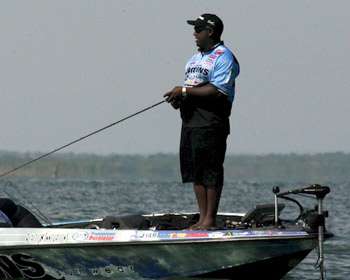
Few things in bass fishing are more frustrating than trying to entice a hesitant bedding bass to commit to your offering. You can see the fish, you can put your bait right next to it, and you can visualize the strike in your mind — but you just can't get the bite no matter how hard you try. On the other hand, there are times when it almost seems too easy to catch bedding bass. You see the bass, make a cast, and set the hook. So, how can you tell if a bedding fish is catchable or if you should move on to greener pastures.
Elite Series pro Ish Monroe has posted numerous Top 10 finishes over the course of his career by sight fishing. For Monroe, the decision to stay and tempt a bedding bass into biting usually comes down to one thing — size.
"At Santee Cooper in 2006, I spent six hours fishing for a bedding 10-pounder because I already had 18 pounds in the boat. I knew that if I caught that single 10-pound bass, I'd have well over 25 pounds for the day," explains Monroe.
While six hours may seem like a ludicrous amount of time to spend on a single bass, Monroe admits that it was an isolated case. When it comes to "typical" bedding bass, Monroe's attention span is much shorter.
"I have what I call 'the 60-second rule.' If I can't see the bass within 60 seconds of pitching a bait on the bed, then I know that fish is uncatchable. But if I pitch it in there and the bass swims into view, then I know my odds of catching it are pretty good. The key then becomes finding what is going to be the trigger to get it to bite," says Monroe.
The California pro also uses his boat as a way to determine if a bedding bass is catchable. While trolling down the bank, Monroe will often pass his boat directly over a bed containing a spawning bass. If the fish remains on the bed or quickly returns to the bed after his boat passes, he deems the bass worth his attention.
When fishing beds occupied by both a male and female bass, Monroe analyzes the interaction between the pair to determine which of the two is more likely to commit to his bait. "Each pair is different," Monroe claims. "If I pitch the bait into a bed and the male pushes the female off the bed, then I know that I'm going to have to catch that male in order to get the female to bite. However, if the female swims off the bed and the male follows her and tries to push her back on the bed, I know that I need to catch the female first, even if the male is biting the bait."
If Monroe is fishing for a large female that is "locked on" the bed but won't commit to the bait, he focuses his attention solely on the bass and not the bed. Monroe explains that bumping the bait into the nose of the fish or suddenly hopping the bait right in front of its nose sometimes triggers a reaction strike.
As a final piece of advice, Monroe stresses the importance of spending the money to obtain a quality pair of polarized sunglasses when bed fishing. Quality eyewear reduces glare and allows the angler to see exactly how the bass is reacting. Without those clues, your odds of catching these fish drop dramatically.
(Provided exclusively to BASS Insider by Z3 Media)




